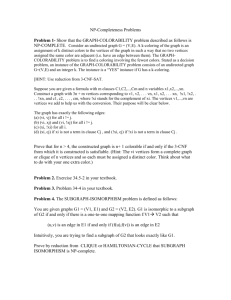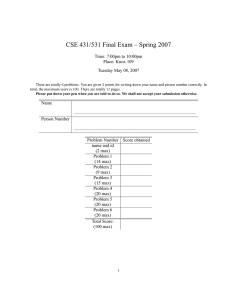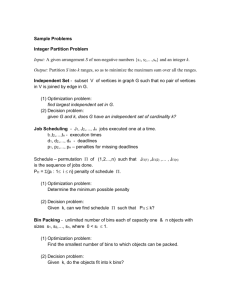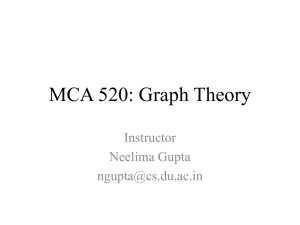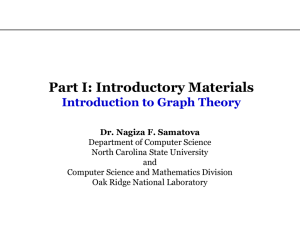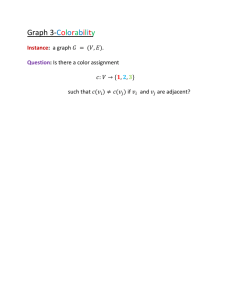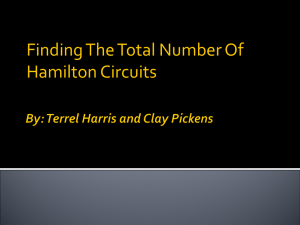PPT
advertisement
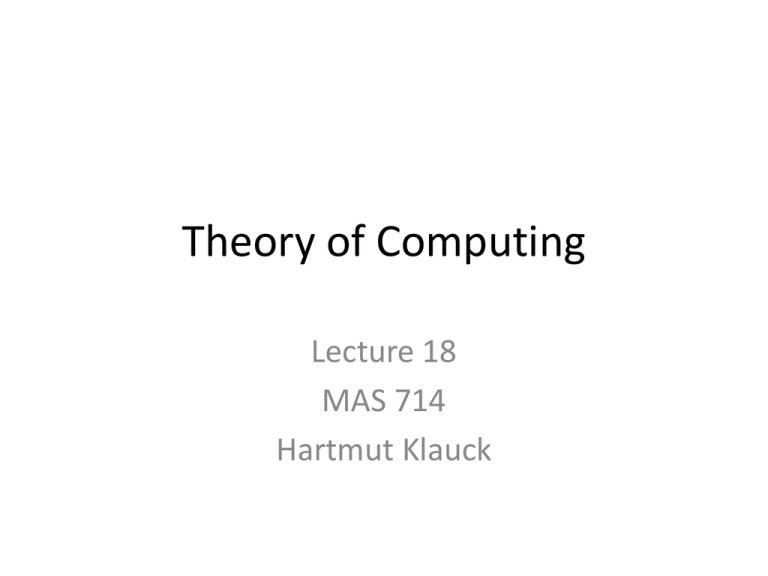
Theory of Computing
Lecture 18
MAS 714
Hartmut Klauck
Before
• We have shown NP-completeness of 3-SAT:
– a k-CNF is a CNF in which all clauses have 3 literals (or
less)
– k-SAT={set of all k-CNF that are satisfiable}
• Notes: Not hard to give a reduction from CNF-SAT
to 3-SAT
• 2-SAT is in P (and hence not NP-complete unless
P=NP)
• 3-SAT is the basis of our reductions from now on
Reductions
• We will show some reductions from 3-SAT to a
few problems
• Due to transitivity we can use reductions from
any of the problems for which we already
have a reduction from 3-SAT
– Often this is easier
Vertex Cover
• For an undirected Graph G a vertex cover is a
subset S of the vertices such that every edge
has at least one endpoint in S
• VC={G,k such that G has a vertex cover of size
at most k}
• Theorem: VC is NP-complete
• Part 1: VC in NP is easy (guess S and check all
edges)
Reduction VC
• Part 2: we reduce from 3-SAT
• Let F be a formula with variables x1,…,xn and
3-clauses z1,…,zm
• For each xi we use two vertices vi and wi
connected by an edge (variable gadget)
• For each zi we use three vertices ai, bi , ci
connected to form a triangle (clause gadget)
Reduction VC
•
•
•
•
vi corresponds to the literal xi
wi to the literal :xi
We connect ai, bi, ci with the corresponding literal from clause zi
We set k to n+2m
• Observation: For any vertex cover S one of vi and wi needs to be in
S, and at least 2 of ai, bi, ci
• 1) Assume x satisfies F. We show that a small S exists.
• If xi=0 we choose wi else vi for S
• For each clause gadget at least one of ai, bi, ci is connected to a
vertex in S. Choose other 2 vertices per clause gadget to form a VC
of size n+2m
Reduction VC
• 2) Now assume there is a VC S of size at most k=n+2m
• S must contain either vi or wi
• S must contain two vertices for each clause gadget
(triangle)
• Hence it cannot contain vi and wi
• Set x accordingly (xi=1 iff vi2 S)
• Claim: this is a satisfying assignment
• Proof: every clause gadget must have one vertex not in
S, connected to a literal node in S
• Hence x satisfies F
Clique
• We want to show that MaxClique is NPcomplete
– Surely it is in NP
• Reduction from VC
• Observation/reduction:
• (G,k)2 VC iff (Gc,n-k)2 Max Clique
– Gc: complement of G
Observation
• If S is a vertex cover in G then all edges in G have one
endpoint in S, there are no edges going from V-S to V-S
• Hence in the complement of G, V-S is a clique
• Gc,n-k in MaxClique
• Note: we have shown that VC has a 2-approximation
algorithm
• Max Clique does not have a n1-² approximation unless
P=NP
– Notice how a VC of size · 2k implies only a Clique of size ¸
n-2k, which can be much smaller than n-k, e.g., k=n/2
SetCover
• Input: set of m subsets s1,…,sn of S, |S|=m
• Task: find the smallest set of si such that
S= [ i2I si
We want |I| minimal
• SetCover:{s1,…,sn,k: there is I µ {1,…,n},
|I|=k, [ i2I si= [i=1…n si }
• Theorem: SetCover is NP-complete
– Part 1: 2 NP: guess I
SetCover
• Part 2: Reduction from VC
• G,k is mapped to a SetCover instance as
follows: G=(V,E)
• Universe: E
• Subsets: s1,…,sn
• si: {edges adjacent to vertex i}
• k unchanged
• Then: (G,k)2 VC iff (s1,…,sn,k) 2 SetCover
Hamiltonian Cycle
• A Hamiltonian cycle in a directed G=(V,E) is a
cycle that visits each vertex once
• HC={G: G has a Hamiltonian cycle}
• Theorem: HC is NP-complete
• In NP: guess the cycle
• Hardness: reduction from VC
HC
• G=(V,E) and k given (input to VC)
• Assume edges in E are ordered (e1,…,em)
• New vertices: a1,…,ak
and vertices (u,e,b) where u2 V, e2 E is incident to u
and b2{0,1}
• Edges: (u,e,0) to (u,e,1)
type 1
(u,e,b) to (v,e,b) where e={u,v}
type 2
(u,e,1) to (u,e’,0) where e,e’ inc. to u and there is no e’’
with e<e’’<e’ inc. to u
type 3
(u,e,1) to all ai where e is max. edge at u
type 4
all ai to (u,e,0) where e is the min. edge at u type 5
HC
• Take vertex cover S of size k
• Find the cycle: for v2 S consider all the vertices (v,e,b)
and all (u,e,b) where e={u,v}
• We traverse these from (v,e,0) in ascending order of e
– (v,e,0) to (v’,e,0) to (v’,e,1) to (v,e,1) to (v,e’,0) etc. until
(v,e,1) for max e at v reached. Then to a1 and to the next
(u,e,0) with u the next vertex in S and e min. at u
• A Hamitonian cycle exists
• Assume a Hamiltonian cycle ex. It must traverse all ai.
Group all vertices visited between ai and ai+1
• Claim: vertex cover of size k exists
Traveling Salesman
• Input: matrix of distances (edge weights),k
• Output: is there a Hamiltonian cycle of total
edge weight at most k?
• Reduction from HC:
– Use adjacency matrix as weights, k=n
Subgraph Isomorphism
• Given G,H, is H isomorphic to a subgraph of G?
– subgraph: subset of vertices and edges
– isomorphic: same up to renaming vertices
• Theorem: Subgraph isomorphism is NPcomplete
• Reduction from Clique: Map G,k to G and H,
where H is a k-clique (undirected case)
• Reduction from HC: Map G to G and H, where
H is an n-cycle (directed case)
Note
• Graph Isomorphism (are G,H isomorphic?)
is not known to be in P or NPC
Subset Sum
• Input: set S of integers, target t
• Is there a subset S’µ S such that the elements
in S’ sum to t?
• Theorem: Subset Sum is NP-complete
• Reduction from 3-SAT
